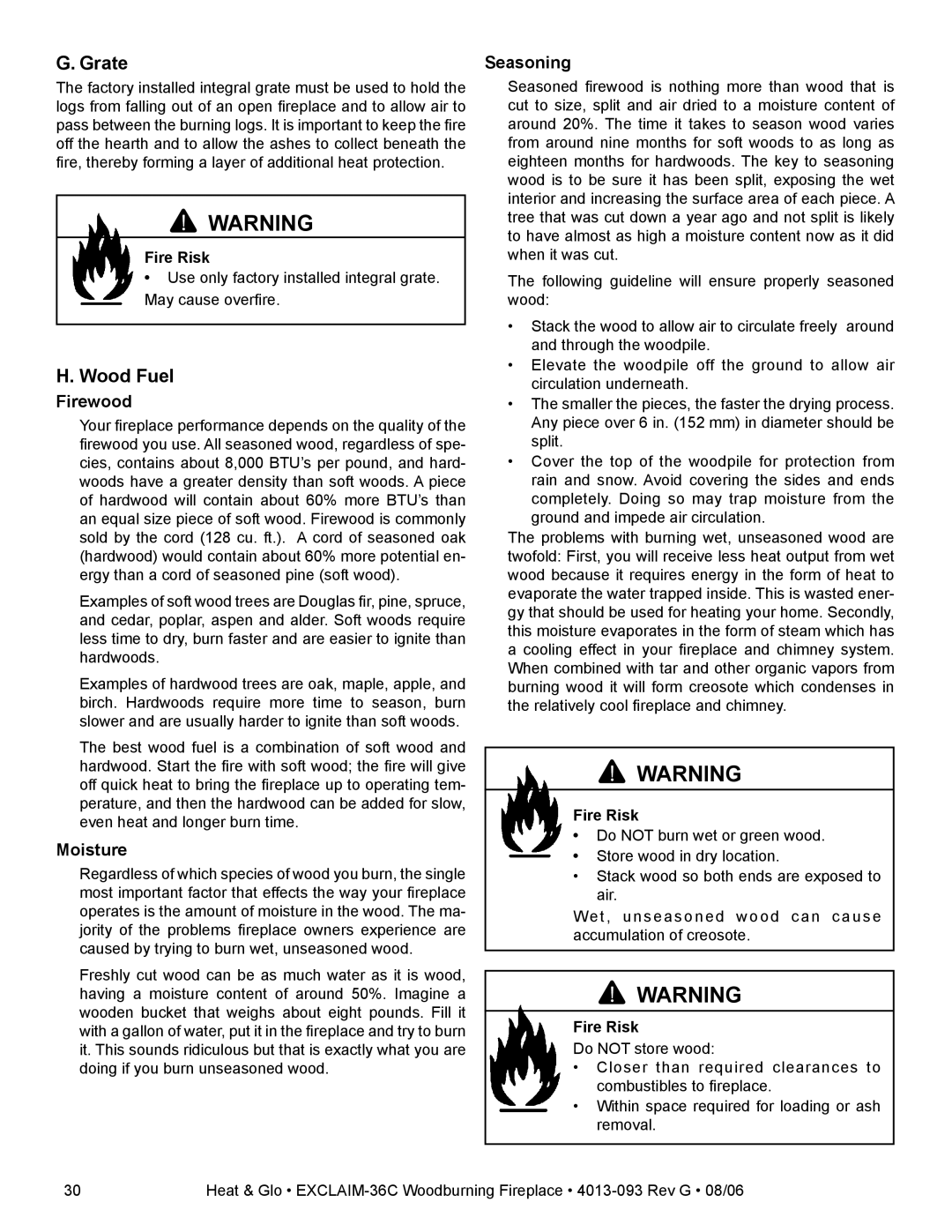
G. Grate
The factory installed integral grate must be used to hold the logs from falling out of an open fireplace and to allow air to pass between the burning logs. It is important to keep the fire off the hearth and to allow the ashes to collect beneath the fire, thereby forming a layer of additional heat protection.
![]() WARNING
WARNING
Fire Risk
•Use only factory installed integral grate. May cause overfire.
H.Wood Fuel
Firewood
Your fireplace performance depends on the quality of the firewood you use. All seasoned wood, regardless of spe- cies, contains about 8,000 BTU’s per pound, and hard- woods have a greater density than soft woods. A piece of hardwood will contain about 60% more BTU’s than an equal size piece of soft wood. Firewood is commonly sold by the cord (128 cu. ft.). A cord of seasoned oak (hardwood) would contain about 60% more potential en- ergy than a cord of seasoned pine (soft wood).
Examples of soft wood trees are Douglas fir, pine, spruce, and cedar, poplar, aspen and alder. Soft woods require less time to dry, burn faster and are easier to ignite than hardwoods.
Examples of hardwood trees are oak, maple, apple, and birch. Hardwoods require more time to season, burn slower and are usually harder to ignite than soft woods.
The best wood fuel is a combination of soft wood and hardwood. Start the fire with soft wood; the fire will give off quick heat to bring the fireplace up to operating tem- perature, and then the hardwood can be added for slow, even heat and longer burn time.
Moisture
Regardless of which species of wood you burn, the single most important factor that effects the way your fireplace operates is the amount of moisture in the wood. The ma- jority of the problems fireplace owners experience are caused by trying to burn wet, unseasoned wood.
Freshly cut wood can be as much water as it is wood, having a moisture content of around 50%. Imagine a wooden bucket that weighs about eight pounds. Fill it with a gallon of water, put it in the fireplace and try to burn it. This sounds ridiculous but that is exactly what you are doing if you burn unseasoned wood.
Seasoning
Seasoned firewood is nothing more than wood that is cut to size, split and air dried to a moisture content of around 20%. The time it takes to season wood varies from around nine months for soft woods to as long as eighteen months for hardwoods. The key to seasoning wood is to be sure it has been split, exposing the wet interior and increasing the surface area of each piece. A tree that was cut down a year ago and not split is likely to have almost as high a moisture content now as it did when it was cut.
The following guideline will ensure properly seasoned wood:
•Stack the wood to allow air to circulate freely around and through the woodpile.
•Elevate the woodpile off the ground to allow air circulation underneath.
•The smaller the pieces, the faster the drying process. Any piece over 6 in. (152 mm) in diameter should be split.
•Cover the top of the woodpile for protection from rain and snow. Avoid covering the sides and ends completely. Doing so may trap moisture from the ground and impede air circulation.
The problems with burning wet, unseasoned wood are twofold: First, you will receive less heat output from wet wood because it requires energy in the form of heat to evaporate the water trapped inside. This is wasted ener- gy that should be used for heating your home. Secondly, this moisture evaporates in the form of steam which has a cooling effect in your fireplace and chimney system. When combined with tar and other organic vapors from burning wood it will form creosote which condenses in the relatively cool fireplace and chimney.
![]() WARNING
WARNING
Fire Risk
•Do NOT burn wet or green wood.
•Store wood in dry location.
•Stack wood so both ends are exposed to air.
Wet, unseasoned wood can cause accumulation of creosote.
![]() WARNING
WARNING
Fire Risk
Do NOT store wood:
•Closer than required clearances to combustibles to fireplace.
•Within space required for loading or ash removal.
30 | Heat & Glo • |
